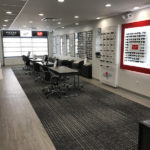By Jennifer L. Stewart, OD
Feb. 17, 2021

Optical dispensary sales typically add up to 60 percent of a practice’s total annual revenues. With so much at stake, I closely track optical metrics to find ways of better serving my patients and helping my opticians to improve their sales performance.
Check Frequently
I like to keep on top of metrics, so I tend to look at key optical indicators at least every few days or weekly. I am usually looking at how the month is progressing, as well as how the quarter looks. I look at all the metrics provided by our dashboard management system, EDGEPro, concentrating on the latest areas of needed improvement. For example, what is our new patient ratio? How does that compare for each doctor? I also look at EDGEPro’s Business Overview for a snapshot of the practice for the month, asking questions like: how is our capture rate? How is our revenue per exam?
Set Ongoing, Top-Line Goals
One of my goals is to always be increasing our revenue per exam and capture rate. We have been adding more doctor days in the practice as we continue to grow, so revenue should be increasing. But is it increasing because we are seeing more patients, or also because our capture rate is increasing, as well as our revenue per exam? If those are going down, but patient exams are going up, it is time to take a look at our optical performance and see where the opportunities may be. This may include new frame lines, a different mix of products and/or staff training.
Drill Down to More Specific Goals
Photochromic penetration is an important, specific metric we pay close attention to. While we are incredibly successful in our anti-reflective lens sales, we can sometimes struggle with our photochromic sales. I try to watch this metric carefully, meeting with my opticians often to talk about best practices for our patients. Tracking this metric closely also serves as a great reminder to ME that I need to continue talking about photochromic lenses in the exam room. We have so much to talk about with patients that is easy to forget (speaking from experience!)
Reminders and data are motivational in showing you that extra, targeted messaging with patients can be extremely impactful in the optical. Metrics take the emotion and guesswork out of how we are doing. We all think we are doing what we need to do (“I’m talking to every patient about photochromic lenses!” But the numbers will tell the story- either we aren’t doing what we think we are, or we need to invest in more staff and doctor training.

The optical in Dr. Stewart’s office. Tracking optical metrics closely, and working with her opticians as a team, is a key to strong patient care and sales, says Dr. Stewart.
Use Metrics to Improve Patient Service & Sales
I show my opticians what we are doing well on (AR lenses) and some areas that we ALL can work together to improve (second-pair sales, overall frame/lens sale, photochromic percentage, capture rate), and discuss how we can do this together. It’s not enough to say “we need to sell more photochromic lenses.” I talk about how I will start the conversation in the exam room, review how to present in the optical, go over insurance coverage and benefits, and provide a reminder that we all need to do our part.
When we all work together on a metric, it is amazing how seamless it is to see positive changes. Whether it is second-pair sales, photochromic lenses, anti-reflective lenses, or overall capture rate, it is impressive how the team can move the dial together. Patients experience better products and better care as they are getting eyewear technology that is important to have, and we are doing a better job explaining the WHY. Patients feel as though they are getting a customized, personalized experience when we talk about the benefits, rather than the features, of eyewear.
The Key Metrics We Track
New patient ratio? How does that compare for each doctor?
Capture rate
Revenue per exam
Anti-reflective lens penetration (percentage)
Photochromic penetration (percentage)
Second-pair sales
Overall frame/lens sales
As our capture rate and revenue per exam increase (because of better doctor and staff engagement), we don’t need to add more patient exams on the schedule to increase revenue. This allows patients not to feel rushed, staff to not feel overwhelmed and doctors not to feel they are falling behind.
I encourage you to choose one metric, and work on that in your practice. For example, can you increase your anti-reflective sales 20 percent? What does that do to your revenue per exam? How many patient encounters would you have had to add to have that same increase?
The national average for Transitions sales is around 20 percent. So, our office has set a goal of having at least 35 percent of eyewear sales include Transitions lenses.
Other Articles to Explore
Looking Ahead
2021 is a wild card at best in terms of optical sales growth projections. While we have experienced growth since reopening in May, not having patients pre-appointed from mid-March through mid-May of last year continues to leave uncertainty. I am concentrating on increasing our optical revenue by increasing our revenue per exam, capture rate, lens options and other key metrics, so we provide excellent care and work smarter, and not harder.
 Jennifer Stewart, OD, is a partner in Norwalk Eye Care in Norwalk, Conn. She also is founder and chief vision officer of Performance 20/20, a sports vision training center in Stamford, Conn. To contact her: jen.stewart@perform2020.com
Jennifer Stewart, OD, is a partner in Norwalk Eye Care in Norwalk, Conn. She also is founder and chief vision officer of Performance 20/20, a sports vision training center in Stamford, Conn. To contact her: jen.stewart@perform2020.com





















